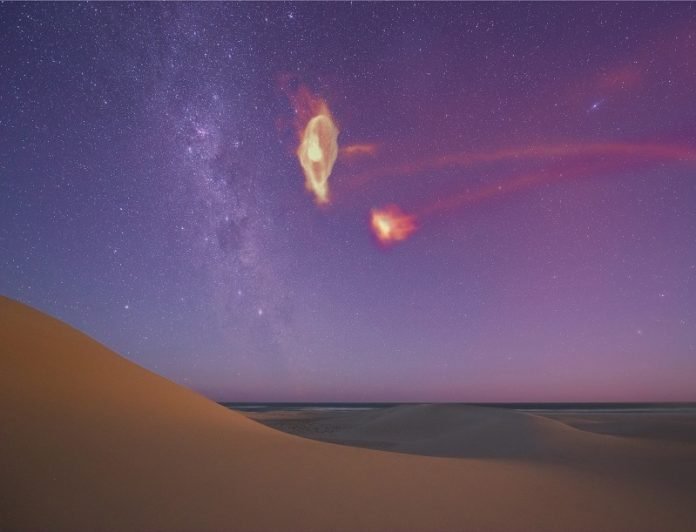
There is a huge halo of gas circling our Galaxy with the mass of a billion Suns.
Stripped from the two dwarf Magellanic galaxies that orbit the Milky Way, the enormous stream of gas spreads over more than a quarter of the southern night sky.
Yet it is only now that astronomers can explain why the Magellanic Stream persists and is as massive as it is.
The researchers publish their findings in the journal Nature.
Over billions of years, the Milky Way has captured smaller galaxies in its orbit and the two largest are known as the Small and Large Magellanic Clouds.
Easily visible to the naked eye in the Southern Hemisphere, they are home to billions of stars and circle each other in an elaborate dance as they speed around the Milky Way.
For 50 years astronomers were puzzled as to why both dwarf galaxies could leave behind a huge trail of gas with as much mass as a billion Suns.
This Magellanic Stream is moving through the Milky Way’s hot gas halo and it should have faded away, like the condensation trail behind an aircraft.
Now, an international team of astronomers has found evidence that both Magellanic Clouds are themselves surrounded by huge hot haloes as well that protect the gas stream from the Milky Way.
Their new model accounts for the huge mass in the gas stream.
Co-author of the study Professor Joss Bland-Hawthorn, Director of the University of Sydney Institute for Astronomy, said: “We are fortunate here in the Southern Hemisphere that we can see these nearby galaxies with the naked eye. Now we know that these stellar smudges are surrounded by hot, huge, gassy spheres that overlap each other.
“If humans could see in the ultra-violet and X-ray spectra, we could see these remarkable structures emitting plasma across much of the night sky.”
Outdated models
The scientists found that as the smaller galaxies were pulled into the Milky Way’s influence, parts of their halo were stretched and dispersed to form the Magellanic Stream.
“The existing models of the formation of the Magellanic Stream are outdated because they can’t account for its mass,” said lead author Scott Lucchini, a PhD student at the University of Wisconsin-Madison in the USA.
His supervisor at Wisconsin-Madison, Professor Elena D’Onghia, said: “That’s why we came out with a new solution that is excellent at explaining the mass of the stream.”
Older models suggested that gravitational tides and the force of the galaxies pushing against one another formed the Magellanic Stream as the dwarf galaxies came into orbit around the Milky Way. While these models could explain the stream’s size and shape, they accounted for just one-tenth of its mass.
Recently, astronomers discovered that the Magellanic Clouds are massive enough to have their own halo, or corona, of warm gas enveloping them. Professor D’Onghia and her team realised this corona would dramatically alter how the stream formed.
“The stream is a 50-year puzzle,” said co-author Dr Andrew Fox, an astronomer at the Space Telescope Science Institute in Baltimore, USA, which operates the Hubble Space Telescope. “We never had a good explanation of where it came from. What’s really exciting is that we’re closing in on an explanation now.”
In new simulations carried out by Mr Lucchini, the creation of the Magellanic Stream is divided into two periods. While the Magellanic Clouds were still far away from the Milky Way, the Large Magellanic Cloud stripped gas away from its smaller partner over billions of years. This stolen gas ultimately contributed 10 to 20 percent of the final mass of the stream.
Later, as the clouds fell into the Milky Way’s orbit, the corona gave up one-fifth of its mass to form the Magellanic Stream, which was stretched across an enormous arc of the sky by interactions with the Milky Way’s gravity and its own corona.
Reservoir for future stars
The new model is the first to explain the full mass of the Magellanic Stream and the vast majority that comes from ionized gas, which is more energetic than non-ionized gas.
It also better explains how the stream adopted its unusual shape and why it lacks stars – because it was formed largely from the star-free corona, not the dwarf galaxies themselves.
“This work refines our understanding of how gas accretes onto the Milky Way and forms the reservoir for future star formation,” said Professor Bland-Hawthorn in the School of Physics at the University of Sydney.
The researchers’ model can now be directly tested. The Hubble Space Telescope should be able to see the tell-tale signatures of the corona of gas surrounding the Magellanic Clouds.
If confirmed, the findings will help explain a half-century mystery about the origin of the stream, offering a fuller picture of our galactic neighbourhood.



